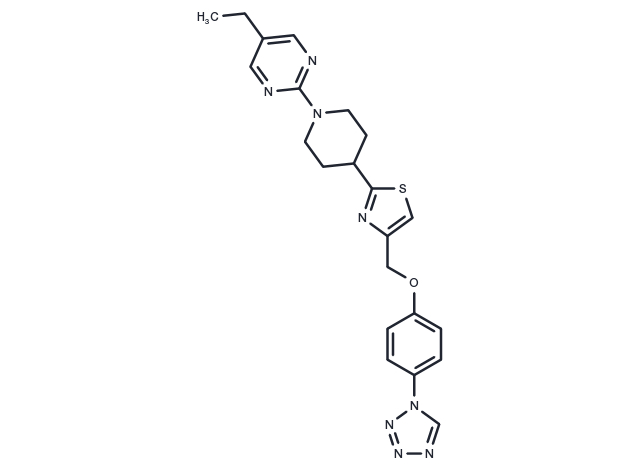Powder: -20°C for 3 years | In solvent: -80°C for 1 year
MBX-2982 is a selective, orally-available GPR119 agonist, used for the treatment of diabetes.

| 説明 | MBX-2982 is a selective, orally-available GPR119 agonist, used for the treatment of diabetes. |
| In vitro | In cells that underwent chronic incubation and subsequent washout with MBX-2982 (1 μM), a significant rise in cAMP levels was observed, as measured by IBMX inclusion, when compared to control cells, indicating enhanced accumulation despite thorough washing to eliminate any excess agonist (P<0.01; ANOVA; n=3-6). Similarly, AR-231,453 elicited prolonged responses within a comparable concentration range to acute exposure, showing a modest increase in potency (1.82-fold difference), with pEC50 values of 8.67±0.11 for sustained exposure and 8.93±0.17 for acute. Furthermore, MBX-2982 displayed a substantial yet smaller alteration in concentration response curves during sustained versus acute exposure (57.54-fold difference), with pEC50 values of 7.03±0.13 for sustained and 8.79±0.12 for acute treatment[1]. |
| In vivo | To determine the physiological relevance of findings in GLUTag and primary intestinal cells, C57BL/6 mice were administered 10 mg/kg of the GPR119 agonist MBX-2982, without co-administration of a DPP-IV inhibitor, to assess the direct effects of GPR119 activation. However, a DPP-IV inhibitor was utilized to maintain active GLP-1 levels in blood samples. Results showed elevated plasma GLP-1 levels in mice treated with MBX-2982, even in the absence of a glucose load, demonstrating that GPR119-induced GLP-1 secretion does not require glucose (2). |
| キナーゼ試験 | HEK-GPR119 cells are transfected with GloSensor 22F plasmid and used for dynamic cAMP measurements 24-30 h later. Cell suspensions are made by dislodging the cells using PBS wash and Accutase treatment followed by resuspension in culture media. Cells are then washed twice by pelleting through centrifugation (300 g, 5 min) and resuspension in assay buffer (Hank's Balanced Salt Solution supplemented with 20 mM HEPES and 0.01% fatty acid free BSA, pH 7.4). Cells are then counted and diluted to 600,000 cells/mL in buffer, before GloSensor cAMP reagent is added (2% v/v) and equilibrated with the cells for 2 h at 20°C with periodic mixing. 50 μl/well of cells are added to white-bottomed 384 well plates (30,000 cells/well) in triplicate and baseline luminescence is measuring using an Envision plate-reader. 5 μL of MBX-2982 (serially diluted in DMSO and then diluted 1:100 in assay buffer to obtain ×10 concentrated solution) is manually added to the assay wells to achieve the stated final concentration. Plates are incubated at 20°C with luminescence read at regular intervals to detect dynamic cAMP changes over time within the same wells. cAMP responses at each time-point are expressed as fold over control (vehicle-treated cells)[1]. |
| 細胞研究 | MBX-2982 is serially diluted in DMSO and then diluted 1:100 in assay buffer to obtain ×10 concentrated solutionis[1]. HEK-GPR119 cells are grown to confluency in flasks, and cell suspensions are made by dislodging cells using PBS wash and accutase treatment followed by resuspension in culture media. Cells are then washed twice by pelleting through centrifugation (227 g, 7 min, 20°C) and resuspension in warm assay buffer (Hank's Balanced Salt Solution supplemented with 20 mM HEPES and 0.01% fatty acid free BSA, pH 7.4), with a 5 min incubation at 37°C after the second wash. Cells are then counted and diluted to 200,000 cells/mL in warm assay buffer[1]. |
| 分子量 | 448.54 |
| 分子式 | C22H24N8OS |
| CAS No. | 1037792-44-1 |
Powder: -20°C for 3 years | In solvent: -80°C for 1 year
DMSO: 50 mg/mL (111.47 mM)
You can also refer to dose conversion for different animals. 詳細
bottom
Please see Inhibitor Handling Instructions for more frequently ask questions. Topics include: how to prepare stock solutions, how to store products, and cautions on cell-based assays & animal experiments, etc.
MBX-2982 1037792-44-1 Endocrinology/Hormones GPCR/G Protein GPR Inhibitor G Protein-Coupled Receptor 119 MBX 2982 GPR119 MBX2982 inhibit inhibitor
